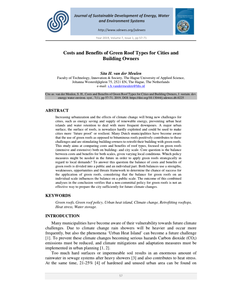Green roofs received increased scientific attention with respect to climate adaptation in urban environments for their hydrological, biodiversity and insulative capacities. Yet, the thermal properties of roofs with an additional water layer underneath the vegetation substrate (blue-green roofs) are not well represented in scientific research. In this field study, we examined the impact of surface temperatures, indoor temperature and insulative properties of blue-green, green, and conventional gravel/bitumen roofs in the city of Amsterdam for early 20th century buildings. Temperature sensor (IButtons) results indicate that outside surface temperatures of blue-green roofs were more stable than for conventional roofs. For instance, for three warm periods during summer (2021) surface substrate temperatures peaked much higher for gravel roofs (+8 oC) or bitumen roofs (+18 oC) than for blue-green roofs. On top of that, during a cold period in winter average water crate layer temperatures remained 3.0 oC higher and much more stable than substrate temperatures of blue-green roofs and conventional roofs, implicating that the blue layer functions as an extra temperature buffer. The effect of lower daily variation of surface temperatures in winter and summer is also reflected by inside air temperatures. Inside temperatures showed that locations with blue-green roofs are less sensitive to outside air temperatures, as daily temperature fluctuations (standard deviations) were 0.19 and 0.23 oC lower for warm and cold periods, respectively, compared to conventional roofs. This effect seems rather small but comprises a relatively large proportion of the total daily variation of 24% and 64% of warm and cold periods respectively.
DOCUMENT

Blue-green roofs have been utilized and studied for their enhanced water storage capacity compared to conventional roofs or extensive green roofs. Nonetheless, research about the thermal effect of blue-green roofs is lacking. The goal of this research is to study the thermal effect of blue-green roofs in order to assess their potential for shielding the indoor environment from outdoor temperature extremes (cold- and heat-waves). In this field study, we examined the differences between blue-green roofs and conventional gravel roofs from the perspective of the roof surface temperatures and the indoor temperatures in the city of Amsterdam for late 20th century buildings. Temperature sensor (iButtons) values indicate that outside surface temperatures for blue-green roofs are lower in summer and fluctuate less during the whole year than temperatures of conventional roofs. Results show that for three warm periods during summer in 2021 surface substrate temperatures peaked on average 5°C higher for gravel roofs than for blue-green roofs. Second, during both warm and cold periods, the temperature inside the water crate layer was more stable than the roof surface temperatures. During a cold period in winter, minimum water crate layer temperatures remained 3.0 o C higher than other outdoor surface temperatures. Finally, also the variation of the indoor temperature fluctuations of locations with and without blue-green roofs have been studied. Locations with blue-green roofs are less sensitive to outside air temperature changes, as daily temperature fluctuations (standard deviations) were systematically lower compared to conventional roofs for both warm and cold periods.
DOCUMENT

Increasing urbanization and the effects of climate change will bring new challenges for cities, such as energy saving and supply of renewable energy, preventing urban heat islands and water retention to deal with more frequent downpours. A major urban surface, the surface of roofs, is nowadays hardly exploited and could be used to make cities more ‘future proof’ or resilient. Many Dutch municipalities have become aware that the use of green roofs as opposed to bituminous roofs positively contributes to these challenges and are stimulating building-owners to retrofit their building with green roofs. This study aims at comparing costs and benefits of roof types, focused on green roofs (intensive and extensive) both on building- and city scale. Core question is the balance between costs and benefits for both scales, given varying local conditions. Which policy measures might be needed in the future in order to apply green roofs strategically in regard to local demands? To answer this question the balance of costs and benefits of green roofs is divided into a public and an individual part. Both balances use a strengths, weaknesses, opportunities and threats framework to determine the chance of success for the application of green roofs, considering that the balance for green roofs on an individual scale influences the balance on a public scale. The outcome of this combined analyses in the conclusion verifies that a responsible policy and a local approach towards green roofs is necessary to prepare the city sufficiently for future climate changes. http://dx.doi.org/10.13044/j.sdewes.d6.0225
MULTIFILE

The message we intend to communicate is that in the future, our cities can (partly) feed themselves with healthy foods grown in microbial gardens, which can be part of a household kitchen or community garden for providing fresh green "vegetables" where the energy for the artificial LED lighting for the microbial garden is coming from solar panels on roofs thereby making this system free from fossil energy.For Floriade 2022, we would like to introduce the Urban Microbial garden pop-up restaurant for feeding and greening the city. The menu will include a speciality microbiota vegan burger made from algae, seaweed, fungi and fava beans served on dishes made from baked mycelium. Our objective is to elicit consumer perception and opinion on the future of our new microbial food chain, which is fully sustainable and safer for the environment. Consumer opinions will be video recorded and compiled into a short movie/video for further inspiration and analysis for product/service development. This pop-up restaurant is a logical extension of the Art-Work by 4F.STUDIO (Kim van den Belt, Joshua Kelly, Steven Wobbes) already present in Kavel 123 at Floriade as part of the Light Challenge. The artwork depicts a future object for community gardens which supports the idea of locally produced microbes. Since we already have work at Floriade, this living-lab project has the benefit of broadening the vision of their work through more in-depth and visceral feedback.